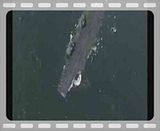|
|
Post by flycookie on May 28, 2008 14:59:40 GMT 12
In the 1980s news vid above about Sea Harrier and helo ops from HMS Invincible, this fella pipes up to answer some of the reporter's daft questions:  While looking at some F-35 pages, the samesaid Mr Hargreaves reappeared. Took a while for this cookie mosnter to connect the name with the old news story, but a quick search proved it to very much be him. This vid shows him doing the first hover and vertical landing test in the (then) X-35 (click on image for vid to play):  www.lockheedmartin.co.uk/news/47.html www.lockheedmartin.co.uk/news/47.html+++At the Lockheed Martin plant in Palmdale, California, BAE SYSTEMS test pilot Simon Hargreaves engaged the lift-fan propulsion system, and the aircraft took off vertically to a sustained hover position at an altitude of about 25 feet above the ground. "This was a stunning success. The lifting power is incredible and the handling is extremely precise," said Hargreaves, a veteran Harrier pilot. "The flight occurred with minimal pilot inputs - I was essentially a passenger. This speaks volumes about the quality of the aircraft and the propulsion system." "The success of the flight is even more notable by the fact that it was achieved at 2,500 feet above sea level, in the desert, where engine performance is typically lower compared operations at sea level," Hargreaves added. "The aircraft hovered at 25 feet above the ground at significantly less than full throttle." Hargreaves held the 35,000-pound X-35B in a stabilised hover position for about two minutes, and executed checks of the flight controls to test the aircraft's handling qualities, before returning the aircraft gently to the ground.+++ Another site said he served on 800 NAS (Hermes, a Sharkey-free zone) during the Falklands, and in one sortie was vectored to intercept an Argie 707, which promptly got the message and scarpered. |
|
|
|
Post by FlyNavy on May 28, 2008 15:41:00 GMT 12
 FREE Winona! Good clip of the F-35 Bewdiful doing its thing. ;D What a great thread this is. Sharkey would be proud (or cranky most likely). ;D |
|
|
|
Post by flycookie on May 30, 2008 12:35:21 GMT 12
Oh the irony of Winona wearing a T-shirt supporting her freedom! Following snippet from the Falklands air diary link as provided by FlyNavy on the Argie artwork thread. Any flying forum members fancy doing a landing in this level of muck? www.cottesmore-ag.com/falklands25.htmlJune 5 (1982) +++Heavy fog descended over the Task Force that night making things very interesting for Lt Cantan of 801 NAS when he returned to and landed aboard HMS Invincible. Using his Sea Harrier's radar he decelerated into a 200ft hover instead of the normal 70ft in the thick fog and moved slowly towards the carrier until he saw a searchlight shining vertically through the gloom, he continued down and landed on the deck of HMS Invincible with visibility less than 50 Yards. In weather conditions such as these it is doubtful any other fixed wing carrier aircraft could have made it back aboard. As Harriers pilots are fond of saying, "It's easier to stop and land than land and stop".+++ |
|
|
|
Post by FlyNavy on May 30, 2008 18:46:57 GMT 12
So Leut CanTan Can CanCan? Leave it out Guv! Are you having a LAFF.  |
|
|
|
Post by flycookie on Jun 6, 2008 6:26:35 GMT 12
This furry blue cookie monster readily and hereby pleads "ignoramus" and "wrong" regarding approaches for vertical DLs by Spanish and Italian navy Harrier drivers. As they have always operated US AV-8s, and not Brit Sea Harriers, I guessed they must do everything by the US book, and paid no heed to the Perfidious Poms. Not so, as they use the RN DAPS meatball system (see page four of this thread for a bunch of close-up pics on RN barges) for their approaches, which are purpose designed and built for the Great Pommy Way. To wit:  (1) Italian floaty boaty Garibaldi, with DAPS fitted atop aft end of the island,  (2) Spanish little 'un, with DAPS above flying bridge at forward end of island,  (3) Spanish gizmo again, looking aft, with a helo maintainer doing the only visible work while two shirkers lurk behind the DAPS, wondering if they can extract the balls, smother them in olive oil, slice them and then scoff 'em down as tapas. The Indian Navy also use DAPS, but as their carrier Viraat is the former RN Hermes and they've only used UK-made birds, that comes as no surprise. I couldn't find a decent pic of the ship avec ball, which explains why I haven't posted one here. If you find one, feel free to jam it 'ere somewhere. Also, I neither know nor care what gadgetry - US, UK or otherwise - the Thais use to get their jets aboard their glorified royal yacht. It was in service yet didn't budge in the aftermath of the tsunami, and therefore doesn't merit an illustration in this thread. Anyway, it will be recalled that the Harriereering countrymen of Mrs FlyCookie and the furry blue sproglets play a different tune in their vertical DLs to their British colleagues - +++We like to approach the ship at 45 degrees and hit one of the spots, but they (ie the Brits) approach from dead astern, come to a hover abeam, slide over, then drop down to the deck. It's different, but you get the hang of it." AND +++The (Marine) pilot makes a 'hover-stop' call to the Landing Signal Officer [LSO], who helps talk the pilot down to a safe landing..........The pilot then adds power as necessary to maintain glideslope position as indicated on the tower's optical landing system..........The LSO says 'clear to cross' and the pilot moves the jet sideways to a hover over the designated spot.......... Once stabilized in the hover, the LSO clears the pilot to land and the pilot eases gent ly down and chops the throttles to idle.+++ To effect this, the USMC use a clunky light set-up called VSTOL OLS, for (insert drumroll) Vertical Short Take Off Landing Optical Landing System. Obviously, over the past 30 years no-one in the USMC has learnt that the correct acronym is actually STOVL, but maybe that's because it would be an ATFEFTM (Acronym Too Far Even For The Marines), and the whole Corps would collapse in a heap of wholly contrived and completely unnecessary unintelligibility. Anyway, this handy pic shows where the VSTOL OLS located on the arse-end of an LHD/A island; 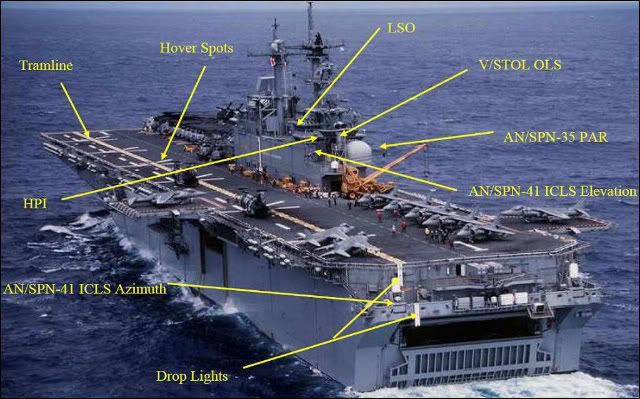 And this schematic shows what it seems impossible to clearly photograph;  Here's what the pwetty wittle lights mean; 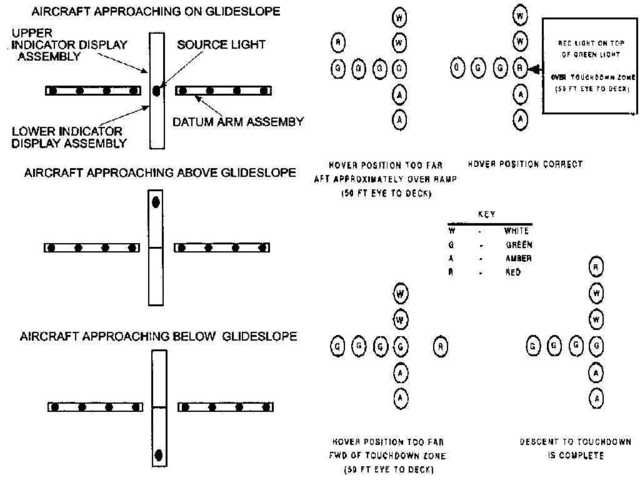 This close-up (cropped from a pic taken from the flight deck) is as good and detailed as it gets. It's impossible to get a front-on shot because there's always a giant bloody mobile crane parked in front of it.  That's it. This is actually an enormous subject, but I've just chucked all this together to illustrate my error and show what yanks earlier in the thread were talking about. QED. |
|
|
|
Post by FlyNavy on Jun 6, 2008 9:56:32 GMT 12
Thanks for that roundup BluCook. Faskinating. Is Winona FREE yet? ;D AND wot ward is Sharkey in please? He seems to have fewer visitors these days.
|
|
|
|
Post by FlyNavy on Jun 7, 2008 15:53:14 GMT 12
frn.beedall.com/cvf1-24.htm "Rolling Landings - SRVL approach - or SHR(U)DLU for short ;D QWERTYUIOP as required. The Lockheed Martin F-35B JSF has a lower payload "bring back" capability when using a vertical landing than the 2300kg that the RN had hoped for - it may therefore be necessary to jettison some unused weapons before landing and with modern weapons being extremely costly this is a significant issue. In the summer of 2004 the MOD asked BAE Systems to investigate the possibility of ship borne rolling vertical landings (SRVL) - an SRVL approach would exploit the ability of the short take-off and vertical landing F-35B to use vectored thrust to slow the speed of the aircraft while still gaining the benefit of wing-borne lift. This offers the possibility of significantly increasing "bring-back" payload compared with a vertical recovery, while also reducing stress on the single-engined aircraft's propulsion system. Factors to be taken into consideration is the cost, feasibility and underpinning safety case of conducting shipborne rolling vertical landings aboard a CVF, adoption could also drive changes to the carrier design, pilot training regime and JCA flight control laws. Following the initial UK studies, the American JSF programme office sponsored a more detailed analysis of the SRVL concept with Lockheed in 2004-5, culminating with a simulator trial at NASA's Ames Research Center in California in late 2005. It was revealed in April 2007 that Qinetiq's VAAC Harrier testbed will be used to demonstrate flight-control limits for a SRVL mode potentially applicable to the Lockheed Martin F-35B Joint Strike Fighter. The VAAC testbed will perform a series of flight trials, potentially using a large-deck aircraft carrier such as the French navy's FNS Charles de Gaulle, and concluding with a final evaluation of a preferred SRVL approach and landing using a "dummy deck" at Boscombe Down around November 2007. An MOD spokesman said "Consideration of the aerodynamic performance of JSF together with the available deck area of CVF design has shown that significant benefits could be realised by extending the principles of land-based RVL to shipborne operations ... the increasing maturity of this body of analysis and simulation indicates SRVL could be performed safely by JSF on CVF, although the effects of equipment failures and adverse conditions require further investigation". Using SRVL F-35B aircraft would approach the carrier from astern at about 60 knots indicated air speed, 35 knots relative assuming 25 knots wind over deck (the maximum speed of a CVF will be 25 knots, so 25kts WOD is achievable even in dead calm) on a steep 5-6 degree glide path. Touch down would be about 150 feet from the stern with a stopping distance of 300 to 400 feet depending on conditions (wet flight deck, pitching ships etc). That would leave around 300 feet of flight deck for margin or even "bolters". The SRVL technique has a significant impact on ship designs and aviation operations, Commander Tony Ray told a conference in February 2008 "We expect to trade some STOVL flexibility for increased bring-back and fuel. We have to .. check for for relevant CV criteria that apply to slower SRVL operations. For example flightpath control will be a far more important flight criteria for SRVL than it has been for STOVL. It is a CV trait creeping in".
|
|
|
|
Post by flycookie on Jun 8, 2008 2:14:09 GMT 12
There's no problem here. All they have to do is tow this behind the carrier.  For EXPERT instruction in the concept and methodoly required, the RN F-35B drivers need only ask the Saudi air force. They proved in Gulf 1 they had, indeed, all graduated with honours from Tornado Top Pickle School. |
|
|
|
Post by FlyNavy on Jun 8, 2008 2:29:03 GMT 12
So it is the pickles turn in the barrel?
|
|
|
|
Post by flycookie on Jun 21, 2008 2:51:14 GMT 12
FlyNavy found his superb 30 minute UK doco about Sea Harrier pilots and those who kept them flying.
Some great footage inside HMS Invincible, including the world's first appetising looking navy food.
It's broken into three parts.
Give it whirl - it's tres bien.
|
|
|
|
Post by flycookie on Jul 6, 2008 4:49:57 GMT 12
|
|
|
|
Post by flyjoe180 on Jul 6, 2008 14:20:53 GMT 12
The three part Fleet Air Arm videos are very good and very interesting.
|
|
|
|
Post by FlyNavy on Jul 6, 2008 14:54:00 GMT 12
Wonder what the rationale is for the separate islands on this new RN huge carrier(s). Probably top weight and to keep the 'chips' separate from the 'fish(heads)'. Sprinkle liberally with vinegar just in case. ;D And wrap in old 'Sharkey Ward' newspapers.
|
|
|
|
Post by FlyNavy on Jul 7, 2008 9:42:16 GMT 12
|
|
|
|
Post by flycookie on Jul 8, 2008 8:13:05 GMT 12
Re the above image - www.iwm.org.uk/upload/package/3/falklands/ext-sharkey.htm12820/4 Commander Nigel 'Sharkey' Ward ++++ As I saw this second Mirage being knocked down, or nearly knocked down, I then thought 'Christ, watch your six o'clock Sharkey' and I was still in the hard turn all the time. I looked round and there was this Mirage passing underneath me, beautiful colours in camouflage. Starting from behind and going towards ahead and all I had to do was pull down hard because I was only at about three hundred feet anyway. I pulled down hard and he was right on the deck and he didn't stand a chance because I got in behind him and fired my missile. It hit basically, a full motor burn out and the whole Mirage exploded and I could see what looked like for example the right wing cart-wheeling along the deck and I thought definitely that guy didn't get out. I could swear to God that guy didn't get out, but he did. He must have seen the missile coming again and ejected, but at this stage he was about, I suppose not very far away, half a mile. I didn't see that, being directly behind. All I saw was a great gout of flame, then all these flaming pieces catapulting into the ground and along the ground. That was very exciting, so we got two confirmed kills much to the delight of the boys in San Carlos. ++++ In other-but-related sports news, I have been baffled for a long time as to how this thread has scored so many hits. After loading "Sharkey Ward" into a simple Google search, it is now obvious as to how this high number occurred -  |
|
|
|
Post by FlyNavy on Jul 9, 2008 11:07:09 GMT 12
|
|
|
|
Post by flycookie on Jul 17, 2008 10:03:06 GMT 12
From 'Approach.' Utterly classic, especially the bit about allt he poms rushing to the tower to "watch the yank crash." He he! safetycenter.navy.mil/media/approach/issues/oct00/harrier.htmA Harrier in the Bristol Channel?by Major Chris ParkhurstAnother beautiful spring day in southern England: 1,000 feet OVC, tops at about 4,000 feet and CAVU above. Not much chance of seeing the sun unless you're a pilot. I was nearing the end of a fantastic three years as an exchange pilot with the Royal Navy and was enjoying my tour as a radar-tactics instructor at the FA-2 Sea Harrier Operational Conversion Unit (OCU). After spending my first two years with a fleet squadron, it was nice to be off the ship and settled into a semblance of a normal routine before heading back to the States. For my second sortie of the day, I was flying as a target for an early phase, all-weather intercept sortie and was bored half-senseless. If you have done an IP tour in a fighter RAG, you can sympathize. If not, imagine flying your fifth or sixth instructional-instrument sortie for the week, and you will get the picture: Your student is trying to eradicate the snakes from his cockpit, and you are ready to roll inverted and pull! Having developed a more creative attitude toward training and the progressive envelope expansion that accompanies it-traits held dear by our Anglo cousins across the Atlantic-I was thinking hard of some way to occupy my time besides flying straight-and-level and taking notes. On my second or third outbound split, I thought, "I wonder if I can fly this thing without touching the stick?" The Harrier-particularly the Sea Harrier-is a naturally unstable platform in flight and requires constant stick-and-rudder attention. Thus, flying it sans control stick would be interesting. I trimmed my jet to straight-and-level and began flying my next turn inbound using rudders, control nozzles and power only. It wasn't pretty, but I could fly the remainder of the sortie without the stick."Another useless bar trick mastered," I thought. "My mom would be proud!" Several weeks later, same weather and I got a great deal: leading a two-ship instructional-BFM sortie for one of the students going through the Air Warfare Instructor Course (Brit version of WTI/SFTI). The sortie was a standardization hop, and all players involved were full-up rounds. This was going to be great! We were ready for 45 minutes of sheer fun before heading back to the wardroom for "tea and medals." Setting up for the next-to-last visual split of an otherwise uneventful sortie, I suddenly found myself 15 degrees nose down, left wing down with a frozen control stick."This is not good," I thought. After calling, "Knock it off," and declaring an emergency, I spent the next couple of seconds with my feet on the dashboard pulling for NATO. No luck there. Cockpit indications normal, hydraulic and stab switches off, stick won't move...time to get out. As I reached for the yellow-and-black-striped handle, it suddenly occurred to me that I had seen this before. Ah, yes, the intercept sortie a few weeks ago. Eleven thousand feet between my pink body and terra firma. Full, right-rudder to wings level. Reduce power and ratchet nozzles downward. Add power to help nose up, and I was straight-and-level. But the stick was still frozen. "Freddy," I called the GCI controller, "give me a steer and range to the nearest coast." At least the Navy won't have to explain why one of their jets wiped out an entire village. Gingerly steering for the Bristol Channel, I continued to troubleshoot my cockpit and prepare for what seemed an inevitable bailout, while my wingman joined for a visual inspection. Finding nothing obvious, he continued to provide me with calm, measured advice to ensure we had our bases covered and hadn't missed any possibilities. I thought, "This is hopeless. I've got two more minutes to feet wet, then I'm stepping out before this thing goes south."I gave another Herculean tug on the control stick, and it was free in pitch. What a morale booster that was. Maybe I could get this thing home after all. My wingman, having had a similar experience, continued to assist my troubleshooting effort with sage advice while coordinating a SAR effort. We discussed the possibility of a level transition and how to do it. I was still unhappy about my prospects for recovery but figured I really had nothing to lose. My wingman offered, "Try to lower your gear." I was feet wet, ready to punch."All down-and-locked," I replied. Then, I tried lowering the flaps. The FA-2 has a wing about the size of an F-14 tailplane, so conventional approach speeds tend to be horrific without full flaps. Again, ready for the worst, I lowered my flaps to full."Flaps are full, and I'm on speed," I called. Having achieved a landing configuration, we now began to discuss the possibility of actually landing the jet with the stick still frozen in the roll axis. I had been flying in this condition for more than 15 minutes now, gotten the gear and flaps down, and flown on-speed. More importantly, I had been able to maintain reasonable control of my jet.Risk management time: I still had a valid ejection option; I was in ideal parameters, but that's always a gamble, even strapped to Martin-Baker's finest. Or, I could try to land this thing before I ran out of fuel, another area quickly becoming a concern for all. After a quick discussion with my wingman, we decided to go for it. Before starting my descent, it was important I decide what deviations I would accept during the recovery phase before I had to pull the handle. I had to be prepared and couldn't let myself get out of the ejection envelope during the in-close-to-touchdown portion of the recovery.We set up for a long, visual straight-in approach, descended through the overcast deck, and began picking our way around the numerous villages in the area. I was on an 8 mile final, field in sight, still rolling around like a top-heavy dump truck, when tower reported winds 90 degrees off at 15-20 knots."Great," I thought.At three miles, the surface winds provided an unwanted diversion as I fought to keep my wings level. I reached for the ejection-seat handle twice. Over the ramp, one last big rudder correction, and I was home. I waved to the many well-wishers who had come outside to watch the Yank crash. They have the same witness rules regarding mishap investigations we do.I taxied to the line, trying to look relaxed as I poured myself out of the cockpit to accept the thanks of a grateful maintenance officer for not leaving one of his precious jets in the Bristol Channel. Three salient points I feel are worth mentioning. I was glad my wingman was with me. People were getting excited on the ground, and he filtered out extraneous calls. Also, I was certain, with his backing, that we had explored every possible option systematically and thoroughly. His assistance was a large factor in my ultimate decision to try a landing.Risk management. Racing through your ORM checklist as you listen to your outbrief is not the way to do it. Military flying is dangerous, and it requires a constant assessment of rapidly changing environments. When the parameters of your flight change, you must be able to quickly reassess your situation and adjust your decision processes accordingly. Waiting to see what happens next is a recipe for disaster. Flight skills and envelope expansion. Rules are great; they are everywhere and usually for good reason, but do we let our desire to fly in the center of the box stifle our growth as aviators? I found the British attitude toward expanding envelopes refreshing, and in my case, a real lifesaver. This doesn't mean I propose we all start flying down runways inverted at 200 feet, but when was the last time you practiced a HUD-out approach in your aircraft, a single-engine failure or explored the published performance envelope of your type and model series? We tend to get wrapped around the axle with tactics while letting basic flying skills degrade. It's a tough balance to maintain, but I'm here to tell you that when things go wrong, your piloting skills, knowledge of your aircraft and ability to think on your feet are what will get you back to the barn in one piece. |
|
|
|
Post by FlyNavy on Jul 23, 2008 14:57:26 GMT 12
|
|
|
|
Post by flycookie on Jul 26, 2008 9:53:04 GMT 12
The Blackrat site quoted above by FlyNavy has a raft of superb aviation pics, and other stuff. The chappie who's phot work is all over it is a full-time UK freelance photo-journo, who seems to have no problems getting nifty slots in service aircraft. Here are some other, Sharkey-related pics: SeaHarrier on Illustrious. The big '450' on the centreline was the starting point for a maximum weight SHAR launch. 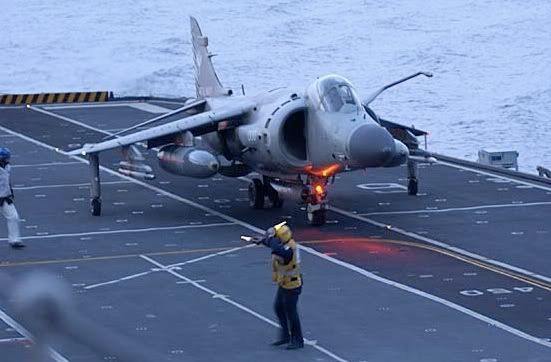 A deck dude turning away from the blast and muck from the SeaHarrier about to go up the ski-jump. Corsair67 will, no doubt, be appalled by the cleanliness of his kit. ;D  Here's a quote relating to his time aboard HMS Illustrious, a year or two before the Sea Harriers were scrubbed - ++++The RAF's GR series Harriers are principally attack aircraft, desgined to deliver offensive air power to targets ashore, wheras the Navy's FA2 Sea Harrier was designed as a fighter jet, to protect assets within a Carrier Group at sea. With the increasing focus on power projection from the sea, the senior service had to accept that proposed upgrades to the FA2 should be sacrificed in favour of investment in the far more potent offensive air capability offered by the GR9 Whilst being fully conversant with the operations of our air force, I was on virgin territory with the Navy and I was standing on a steep learning curve. After dressing for dinner in the Wardroom where I met with the ships' senior officers, I just had time to change back into working dress for the night time flying operations from the newly refitted flight deck. I spent some considerable time that day chatting to the embarked ranks of the RAF, interested in hearing the perspective of men who had joined Britain's air service and who had then been sent to sea. The feedback wasn't all positive, but it was thoughtful and considered - and given that the men had only been at sea for three days, bound to be unshaped by experience. Useful all the same though. ++++ Photo-journo on the right, with caption from his site below the pic. Couldn't find his name anywhere on the site, BTW.  ++++ Top Gun II - The Sequel: Ready for action, dressed in flight suit and standing proudly beside the Sea Harrier T8 with Commander Henry Mitchell, RN - a man more colloquially known as Commander SHAR ( Sea HARrier) As I said, all this from the Blackrat URL in FlyNavy's post of the illuminated DAPS meatball pic above. |
|
|
|
Post by FlyNavy on Jul 28, 2008 13:20:13 GMT 12
Come back Sharkey, we need you:  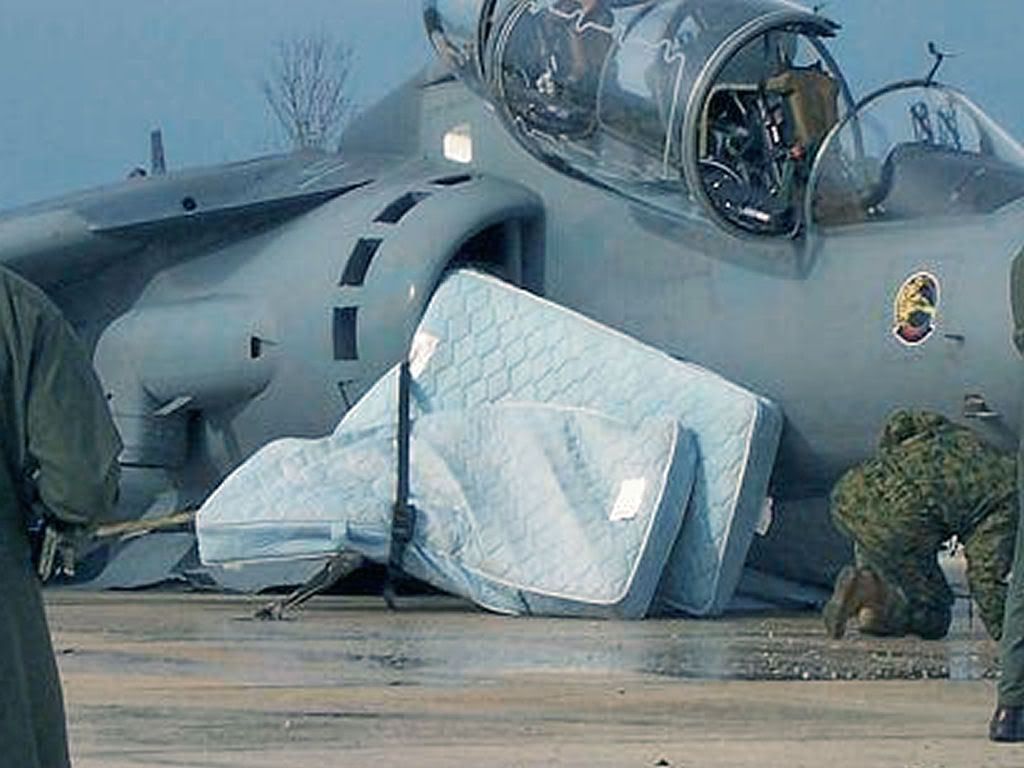 "To quote the guy who showed the pics: ------------------------------------------------------------------- Basically, the nose gear wouldn't come done. The Harrier has a backup system with a nitrogen bottle to blow the gear down in this event. Well, someone significantly outranking the pilot ordered him not to blow the gear down (which is the specified emergency procedure) b/c by his reasoning, if the nose gear didn't come down, he was afraid the jet would break its back by having all that weight on the long nose of the T-bird. With that, he elected to gather mattresses and strap them down to support the extended nose, and you have the obvious result. 'Normally' a Harrier that can't get it's gear to come down will suck up the gear and do a vertical landing on the strakes/gun pack, they'll jack the bird up, fix the gear, and it's back to flying rather quickly. In this case, the motor was hilariously trashed with mattress springs protruding out and everything. This has since become a legendary event in the Harrier community (rather small community) and is laughed about often. The best part was, when they jacked the plane up in the hangar and pulled the gear handle to blow them down, all 4 came down and locked in place." |
|

















